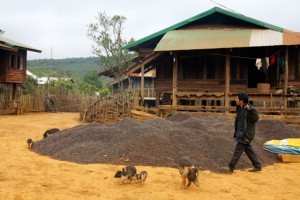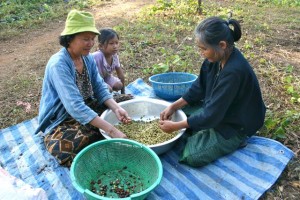Project Sekong 2012: Packin’ for action. Stretcher? Check! Tourniquets? Check! Coffee? Whaaa? Where’s the coffee?

Most families in this village have begun growing coffee as a cash crop. Most farms are small but collectively the farmers secure an abundant harvest.
Report 39
While preparing for a mission like ours, we must consider certain critical measures. Is the medic kit fully supplied with tourniquets and other life-saving equipment? Has the team practiced moving a trauma victim via stretcher? Are hospitals along our route aware of our presence and prepared to receive victims? Do we have sufficient coffee to see us through the entire project?
I’m the guy who brought eight pounds of coffee to a project next door to the Bolaven Plateau, the premier coffee region of Laos. Is that worse than carrying coal to Newcastle? Without a doubt, but you can’t be too careful.
In the middle of the last century, before war came to Southeast Asia, Lao coffee was exported around the globe and had a loyal following among discerning consumers. It’s said that coffee brewed from Lao Arabica beans had great cache in Parisian cafes and was marketed as “the Champaign of coffee.”
If the Vietnam War had been just an interruption, the Bolavens might have quickly reclaimed its status after fighting ended. But…the war was no brief interlude. Legacies of that conflict continue to impact production today.
Many coffee planters and their families were made internal refugees. When they were finally able to return to the Bolavens they found that their land, once the best coffee growing soil in Asia, was contaminated with unexploded ordnance. Bolaven families turned to other pursuits and Laos lost a reservoir of coffee knowledge.
Fortunately, in recent years there has been a resurgence of interest in Lao coffee. The children and grandchildren of farmers put out of coffee production by the war are requesting that their land be cleared of UXO so they can commence planting trees. When I first traveled through the Bolavens ten years ago I saw coffee trees, drying racks, and other signs of production but evidence of a coffee revival was modest compared with the efforts I see now.
Here in Sekong, just east of the Bolaven Plateau, the mountainsides above every village are speckled with groves of coffee trees (Good trees — “Typica” a highly-regarded sub species of Arabica). Landless, but enterprising, villagers have planted trees within the village proper, often right up to the front door of their house.
Today in Dak Door, I’ve got my eye on a huge pile of coffee “cherries” dumped on the ground in the center of the village. (Freshly picked, with the bean still within the fruit) The family that owns that harvest has been adding to the pile all morning. Family members, old and young, disappear for a while but eventually return to dump another teeming basket of beans on the pile, which currently stands waist high and twenty feet in diameter. Pigs nibble at the edge of the pile but no one pays them much mind, so great is the harvest. After all, the family must feed the pigs something; why not share a crop they have in abundance?
Among the livelihood projects that we’re assisting here there are several that focus on increasing coffee production. As soon as we finish clearing rice fields along the valley floor, we’ll literally head for the hills and start clearing land for coffee trees.
We’ve seen thousands of coffee tree seedlings growing under shade structures, ready for transplantation when land is finally made safe for cultivation.


I gave this wonderful coffee to family and friends for a holiday gift last year! Everyone loved it! I felt so good about contributing to the Help War Victims organization in this way. It was a win win! Thank you for all you do Jim. We are waiting for more wonderful coffee and tea! God bless.